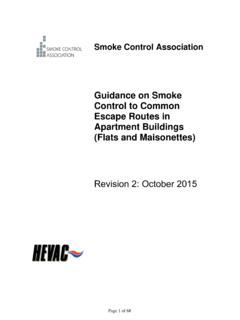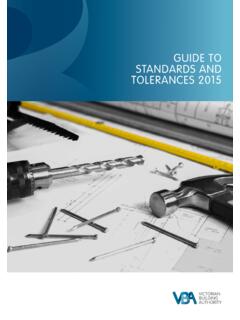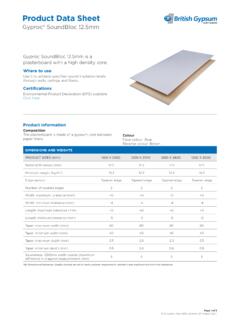Transcription of THERMAL BRIDGING GUIDE - LABC
1 THERMAL BRIDGING GUIDEAn introductory GUIDE to THERMAL BRIDGING in homesFurther copies of this GUIDE are available as a PDF download from Or contact usZero Carbon HubLayden House 76-86 Turnmill Street London EC1M 5LG T: 0845 888 7620 E: ConsultantsExpert and approachable technical consultants on building performance, THERMAL modelling, construction product development and : 01256 892211 E: Technical Centre Provides a service offering that focuses on helping customers deliver energy efficient to SIG360 is an easily accessible impartial team of technical specialists, who draw on over 55 years of experience and an extensive range of products in providing the most cost effective build, suited to your preferred building TSThe Zero Carbon Hub is very grateful to the following contributors/organisations for their involvement in developing this Luke Whale, C4Ci ConsultantsProject AdvisorsRob Pannell, Tessa Hurstwyn, Ben Griggs, Zero Carbon HubGraphic Design and IllustrationRichard Hudson, GroupRichard Bayliss, CITB Andrew Carpenter, Structural Timber Association Chris Carr.
2 Federation of Master Builders/Carr & Carr Builders Darren Dancey, Crest Nicholson Tom Dollard, Pollard Thomas Edwards Milicia Kitson, Constructing Excellence in Wales Mike Leonard, Building Alliance Paul McGivern, Homes & Communities Agency Andrew Orriss, SIG Plc Richard Partington, Studio Partington Graham Perrior, NHBC John Slaughter, Home Builders Federation Barry Turner, LABCTHERMAL BRIDGING GUIDE | ZERO CARBON HUB 1 INTRODUCTION 2 UNDERSTANDING THE DETAIL PAGES 3 THERMAL BRIDGING EXPLAINEDWHAT ARE THERMAL BRIDGES? 4 HOW IS FABRIC HEAT LOSS QUANTIFIED? 5 KEY DETAILS MASONRY CONSTRUCTIONTOP THERMAL BRIDGING TIPS: MASONRY CONSTRUCTION 7E2 INDEPENDENT LINTEL 8E2 PERFORATED STEEL LINTEL 8E3 WINDOW SILL 10E4 WINDOW JAMB 10E5 GROUND BEARING FLOOR TO EXTERNAL WALL 12P1 GROUND BEARING FLOOR TO PARTY WALL 12E5 BEAM AND BLOCK FLOOR TO EXTERNAL WALL 14P1 BEAM AND BLOCK FLOOR TO PARTY WALL 14E10 EAVES (COLD ROOF) 16E12 GABLE (COLD ROOF) 18P4 PARTY WALL HEAD (COLD ROOF) 20 KEY DETAILS TIMBER FRAME CONSTRUCTIONTOP THERMAL BRIDGING TIPS.
3 TIMBER FRAME CONSTRUCTION 23E2 TIMBER FRAME LINTEL 24E3 WINDOW SILL 26E4 WINDOW JAMB 26E5 GROUND BEARING FLOOR TO EXTERNAL WALL 28P1 GROUND BEARING FLOOR TO PARTY WALL 28E5 BEAM AND BLOCK FLOOR TO EXTERNAL WALL 30P1 BEAM AND BLOCK FLOOR TO PARTY WALL 30E6 INTERMEDIATE TIMBER FLOOR 32E10 EAVES (COLD ROOF) 34 TECHNICAL ANNEXPRINCIPLES FOR IMPROVING JUNCTION PERFORMANCE 38 THE BENEFITS OF JUNCTION IMPROVEMENT IN SAP 39 SAP BUILDING JUNCTIONS ILLUSTRATED 40 IDENTIFYING THE MOST SIGNIFICANT BUILDING JUNCTIONS 42 PSI VALUE SENSITIVITY SUMMARIES FOR MASONRY AND TIMBER FRAME CONSTRUCTION 44 The Technical Annex can be found in the electronic version of this GUIDE available at THERMAL BRIDGING GUIDE | ZERO CARBON HUB This document provides a simple GUIDE to what THERMAL BRIDGING is, the key construction details in new build housing where THERMAL BRIDGING is particularly significant.
4 Examples of ways in which heat loss can be reduced by changes to the design and construction of these details, and the problem areas to avoid on is intended to help designers and builders focus on the key decisions that they can affect around junction detailing which will have a direct bearing on the performance of the new homes they help to GUIDE begins with a few explanatory pages describing what THERMAL bridges are and how their effects are construction details are then illustrated for both masonry and timber frame construction showing how their THERMAL performance can either be improved or compromised by adopting alternative construction details, material specifications or site practices. This is the main part of the electronic version of this GUIDE also contains an Annex aimed at those who would like further information, covering: general principles to improve junction performance, the benefits in SAP of improved junction details, illustrated guidance to identify all relevant linear THERMAL bridges, how to establish the key junctions for a particular dwelling type, and a summary of the results of the PSI-value modelling work carried out for this Note The details drawn in this GUIDE are for illustrative purposes only and should not be used as working drawings.
5 For example, consideration must also be given to structure, waterproofing, airtightness, general good practice and sequencing on site. The PSI-values quoted in this GUIDE are for indicative purposes only and should not be used in SAP sources exist to obtain PSI-values for the building junctions of interest, as follows: OGeneric industry sponsored libraries covering the common building types LABC ( ) or Scottish Standards ( ) OIndividual product or building system manufacturer sponsored libraries, covering specific building products/systems. OBespoke PSI-values calculated by competent persons for specific THERMAL BRIDGING GUIDE | ZERO CARBON HUB 3 Construction detail type (with SAP Table K1 reference)Red themes = problem areas to be avoided and checked on siteBlue themes = base construction (assumed starting point)Green themes = possible design improvementsAdditional useful informationFor indicative purposes only, black mould risk is identified where this becomes a likely consequence of problem detailsHeat loss path illustrated by blue arrowsPrimary responsibility:MasonryBuilderTimber FrameBLACK MOULDPROBABLEC onstruction type.
6 DesignerBLACK MOULDPOSSIBLE GUIDE PSI-values are displayed in theme coloured circlesUNDERSTANDING THE DETAIL PAGES4 THERMAL BRIDGING GUIDE | ZERO CARBON HUB REPEATING AND NON-REPEATING THERMAL BRIDGEST here are two types of THERMAL bridges in buildings - repeating and non-repeating THERMAL of repeating THERMAL bridges are mortar joints and wall-ties in masonry construction or timber or steel studs in framed construction. Where the frequency of these is known and consistent their effects can be accounted for directly in the U-value calculation for the building element remaining non-repeating THERMAL bridges are dealt with by PSI-values pronounced Si (silent p), and designated by the Greek letter . Their effects on heat loss are calculated by THERMAL modelling software, and they are accounted for separately in SAP calculations in addition to ARE THERMAL BRIDGES?
7 A THERMAL bridge (sometimes called a cold bridge) is a localised weakness or discontinuity in the THERMAL envelope of a building. They generally occur when the insulation layer is interrupted by a more conductive type of THERMAL bridges considered in this GUIDE are called non-repeating or linear THERMAL bridges. These occur at junctions between elements, such as a wall and a floor or a window and a wall. At these locations heat is more able to transfer through the construction, resulting in greater heat loss from the dwelling and localised cold spots in the building junction details to reduce linear THERMAL BRIDGING will help achieve Building Regulations compliance and is one component in achieving healthy low energy EFFECTS OF THERMAL BRIDGESI ncreased heat lossThermal bridges can account for 20-30% of the heat loss in a typical new build home.
8 As homes become better insulated THERMAL bridges become even more cold-spots Sometimes leading to condensation build-up or mould JUNCTIONSA lthough there are many junctions within a dwelling, some have extremely low PSI-values and others occur over very short lengths. The key junctions to get right or improve are those which either have a high PSI-value or occur frequently over significant lengths. Although the particular junctions of interest will vary depending on dwelling type and design, this GUIDE covers the key junctions considered by the authors to be the most significant across a range of dwelling (mortar joints)Non-repeating (wall junction) THERMAL BRIDGING GUIDE | ZERO CARBON HUB 5 The sum of the individual junction heat losses divided by the total exposed surface area of the dwelling gives the Y-value.
9 The Y-value expresses the overall heat loss arising from all of the building junctions as an equivalent U-value for the the heat loss from each of the junctions where the building elements meet ( THERMAL bridges). Multiplying the junction PSI-value by the junction length gives the junction heat the heat loss from each of the external building elements such as floors, walls, windows, doors etc. The area of each element multiplied by its U-value gives its anticipated heat IS FABRIC HEAT LOSS QUANTIFIED?ELEMENT U-VALUES (W/m2K)DWELLING Y-VALUE (W/m2K)In SAP fabric heat loss is quantified by a combination of U-values and Y-valuesTOTAL FABRIC HEAT LOSS+=U-VALUES x ELEMENT AREASELEMENT LOSSES70 - 80% of fabric heat lossY-VALUE x TOTAL EXPOSED SURFACE AREATHERMAL BRIDGE LOSSES20 - 30% of fabric heat lossELEMENT LOSSESJUNCTION PSI-VALUES (W/mK) THERMAL BRIDGE LOSSESNote: Lower U-values, Y-values and PSI-values will result in lower fabric heat THERMAL BRIDGING GUIDE | ZERO CARBON HUB MASONRY CONSTRUCTIONTHERMAL BRIDGING GUIDE | ZERO CARBON HUB 7 TOP THERMAL BRIDGING TIPSMASONRY CONSTRUCTION KEY DESIGN RECOMMENDATIONSD esign recommendationNo.
10 Of junctions affectedJunction references1 Use a split or thermally broken lintel1 E2 (page 8)2 Use light aggregate blockwork inner leaf4E5, P1, E12, P4 (pages 12, 14, 18, 20)3 Use a PU/PIR cavity closer3E2, E3, E4 (pages 8, 10)4 Use insulated plasterboard on the inner leaf5E2, E4, E10, E12, P4 (pages 8, 10, 16, 18, 20)5 Use a window frame overlap of min. 50mm3E2, E3, E4 (pages 8, 10)6 Increase eaves insulation depth1E10 (page 16) KEY PROBLEMS TO AVOIDP roblem / site checkNo. of junctions affectedJunction referencesBlack mould risk1 Omitting rafter insulation at eaves1 E10 (page 16)2 Omitting insulation between truss and wall2E12, P4 (pages 18, 20)3 Omitting soffit insulation at eaves1E10 (page 16)4 Stopping party wall cavity insulation short of loft1P4 (page 20)5 Swapping a split lintel with a perforated steel lintel1E2 (page 8)6 Omitting the cavity closure3E2, E3, E4 (pages 8, 10)7 Omitting cavity insulation below DPC2E5, P1 (pages 12, 14)8 Omitting floor perimeter insulation2E5, P1 (pages 12, 14)9No window frame overlap with cavity3E2, E3, E4 (page 8, 10)BLACK MOULDPROBABLEBLACK MOULDPROBABLEBLACK MOULDPOSSIBLEBLACK MOULDPOSSIBLE8 NB.








